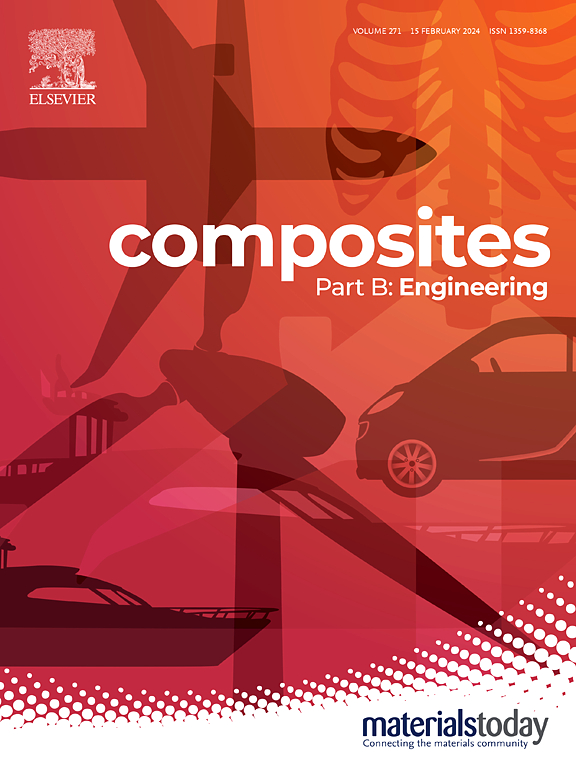高性能,环保碳酸钙水泥通过海藻酸介导的仿生矿化
IF 12.7
1区 材料科学
Q1 ENGINEERING, MULTIDISCIPLINARY
引用次数: 0
摘要
碳酸钙基粘合剂具有显著的环境优势,特别是在碳捕获和可持续建筑方面。受生物矿化中有机基质的启发,本研究探讨了海藻酸钠作为增强碳酸钙水泥的功能添加剂和基质。在矿化系统中加入1.5 wt%的海藻酸钠,在28天的固化后,产生了轻质复合材料,抗压强度为46兆帕,弹性模量为800兆帕,与不含海藻酸盐的样品相比,分别提高了1084%和155%。采用x射线衍射、热重分析、衰减全反射红外分析、扫描电镜和透射电镜等方法对藻酸盐对其相演化和结构发育的影响进行了广泛的表征。海藻酸盐是关键在成核和稳定无定形碳酸钙,定向其随后转变为球晶方解石。压缩下的微计算机断层扫描分析揭示了海藻酸盐复合材料的特殊弹性和韧性。进一步阐明了压缩前、压缩中、压缩后复合材料内部不同特征的稳定和结晶缺陷分布。这些发现强调了生物聚合物介导的矿化在工程高性能胶凝碳酸钙复合材料中的关键作用。除了二氧化碳隔离之外,这种环保材料在可持续建筑和先进的复合材料系统中也有很好的应用前景。本文章由计算机程序翻译,如有差异,请以英文原文为准。
High-performance, eco-friendly calcium carbonate cement via alginate-mediated biomimetic mineralisation
Calcium carbonate-based binders offer significant environmental advantages, particularly in carbon capture and sustainable construction. Inspired by the organic matrix in biomineralisation, this study investigates sodium alginate as a functional additive and matrix to enhance calcium carbonate cement. Incorporating 1.5 wt% sodium alginate within the mineralisation system yielded a lightweight composite with a compressive strength of 46 MPa and an elastic modulus of 800 MPa after 28 days of curing – improvements of 1084 % and 155 %, respectively, compared to alginate-free samples. The phase evolution and structural development influenced by alginate were extensively characterised using X-ray diffraction, thermogravimetric analysis, attenuated total reflection infrared analysis, scanning electron microscopy, and transmission electron microscopy. Alginate was pivotal in nucleating and stabilising amorphous calcium carbonate, orienting its subsequent transformation into spherulitic calcite. Micro-computed tomography analysis under compression revealed the exceptional elasticity and toughness of the alginate composites. It further elucidated the defects distribution of different features of the stabilisation and crystallisation within the composites before, during, and after compression. These findings underscore the critical role of biopolymer-mediated mineralisation in engineering high-performance, cementitious calcium carbonate composites. Beyond CO2 sequestration, this environmentally friendly material offers promising applications in sustainable construction and advanced composite systems.
求助全文
通过发布文献求助,成功后即可免费获取论文全文。
去求助
来源期刊

Composites Part B: Engineering
工程技术-材料科学:复合
CiteScore
24.40
自引率
11.50%
发文量
784
审稿时长
21 days
期刊介绍:
Composites Part B: Engineering is a journal that publishes impactful research of high quality on composite materials. This research is supported by fundamental mechanics and materials science and engineering approaches. The targeted research can cover a wide range of length scales, ranging from nano to micro and meso, and even to the full product and structure level. The journal specifically focuses on engineering applications that involve high performance composites. These applications can range from low volume and high cost to high volume and low cost composite development.
The main goal of the journal is to provide a platform for the prompt publication of original and high quality research. The emphasis is on design, development, modeling, validation, and manufacturing of engineering details and concepts. The journal welcomes both basic research papers and proposals for review articles. Authors are encouraged to address challenges across various application areas. These areas include, but are not limited to, aerospace, automotive, and other surface transportation. The journal also covers energy-related applications, with a focus on renewable energy. Other application areas include infrastructure, off-shore and maritime projects, health care technology, and recreational products.
 求助内容:
求助内容: 应助结果提醒方式:
应助结果提醒方式:


